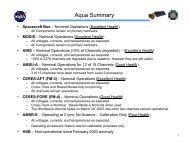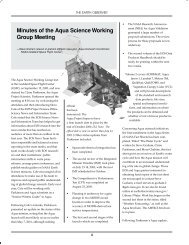CERES - Aqua - NASA
CERES - Aqua - NASA
CERES - Aqua - NASA
You also want an ePaper? Increase the reach of your titles
YUMPU automatically turns print PDFs into web optimized ePapers that Google loves.
Climate Change and FeedbacksFor centuries, mankind has engaged in activities that alter the environment and, potentially, the global climate.Fossil fuel burning and release of other trace gases and aerosols may well have significant long-term consequences.Since 1800, atmospheric carbon dioxide has increased by 25% and methane concentrations havemore than doubled. Agriculture and deforestation alter the Earth’s surface in ways that have the potential tochange the climate. In these and many other examples, the immediate impacts of man’s activities are understood,yet the long-term consequences on the Earth-atmosphere system cannot easily be predicted. For example,one of the major sources of uncertainty in predicting climate change lies in the impact of clouds upon theradiative energy flow through the Earth-atmosphere system. The largest uncertainty in climate predictionmodels is how to correctly account for the effects of clouds. Because of the importance and uncertainties ofclouds and radiation fields, they have become one of the top scientific priorities in the U. S. Global ChangeResearch Program.As the Earth undergoes changes in its climate, the amount of cloud cover as well as the physical propertiesof clouds may well change in ways that are not yet understood. The complex interaction between a changingclimate system and the changing cloud conditions is called cloud-climate “feedback.” Do clouds decreaseor increase global warming? Will a warmer climate result in fewer or more clouds? Can a “runaway greenhouseeffect” occur as it did on the planet Venus? While we cannot as yet provide definite answers to such questions,the sensitivity results shown below indicate that relatively small changes in global cloudiness can have a largeimpact on our climate system. For example, a 50% increase in carbon dioxide may warm the Earth much lessthan a 50% increase in the amount of high cirrus clouds.20Climate SensitivityEarth Warming10Radiative Effect atthe Top o f Atmospherefor a 50% Increase in0Climate Parameter2(Watts/meter )Earth Cooling-10Low CloudAmountHigh CirrusAmountCloudHeightCloudOptical DepthParticle Size(Low Clouds)Indirect AerosolForcingDirect AnthropogenicAerosol ForcingStratosphericOzoneLandAlbedoCarbonDioxide-204





